Cold Chain Logistics: Management Challenges & Solutions
The supply chain is a term used to describe all the components required to transport goods from beginning to end, from production to the end...
11 min read
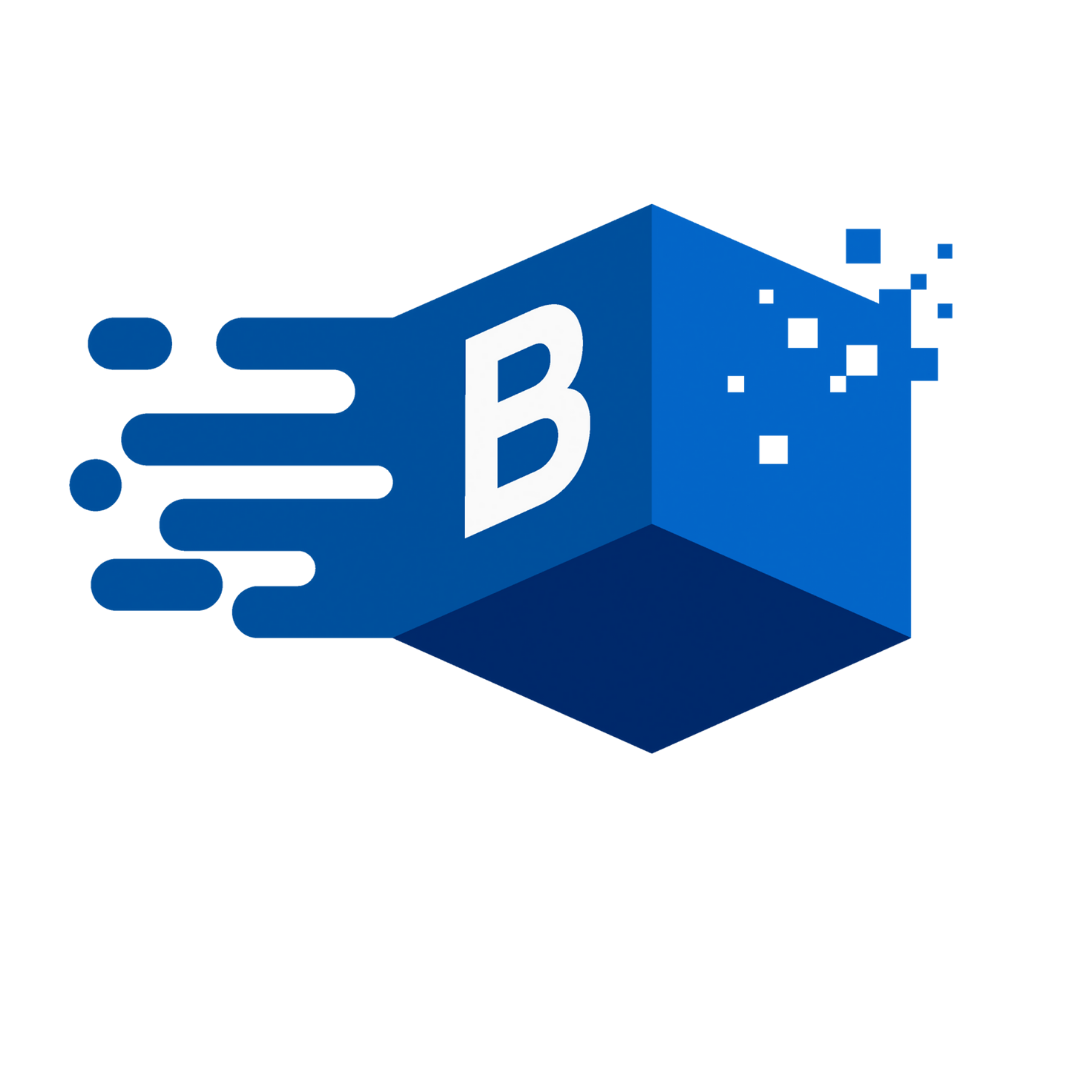 BUKU Marketing
:
Aug 2, 2023 1:00:00 PM
BUKU Marketing
:
Aug 2, 2023 1:00:00 PM
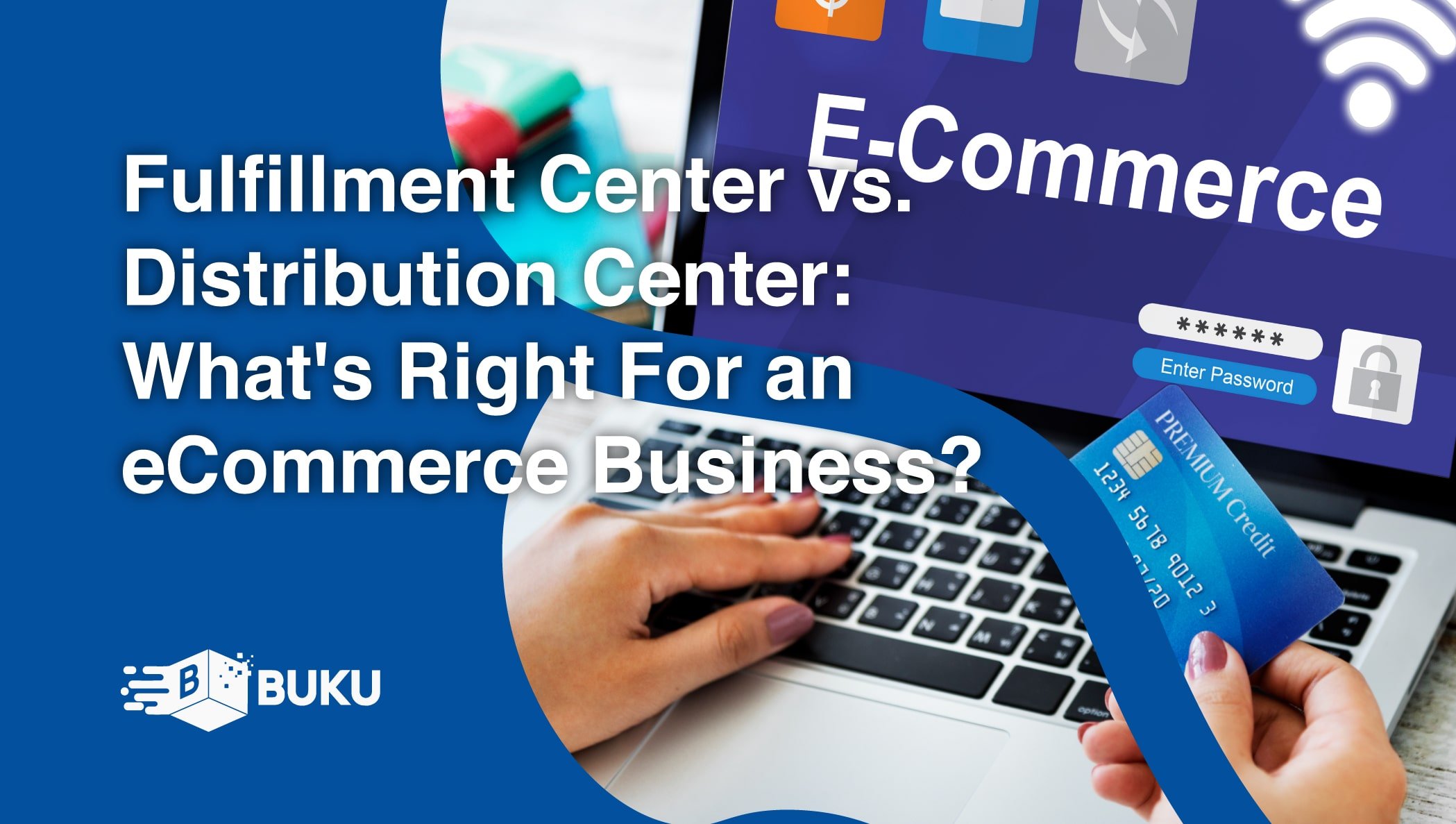
Ecommerce is big business. Around a decade ago, eCommerce accounted for just 8% of all retail purchases. Today, that figure hovers around 23%. And analysts expect US eCommerce sales to jump to around 31% by 2026.
Table of Contents
2. How to Choose a Fulfillment Center
3. Advantages of Fulfillment Centers
5. How to Choose a Distribution Center
6. Advantages of Distribution Centers
7. Key Differences in Fulfillment Center vs. Distribution Center
8. Suitability for eCommerce Businesses
9. Cost Considerations for Fulfillment vs. Distribution Center
10. Returns & Reverse Logistics
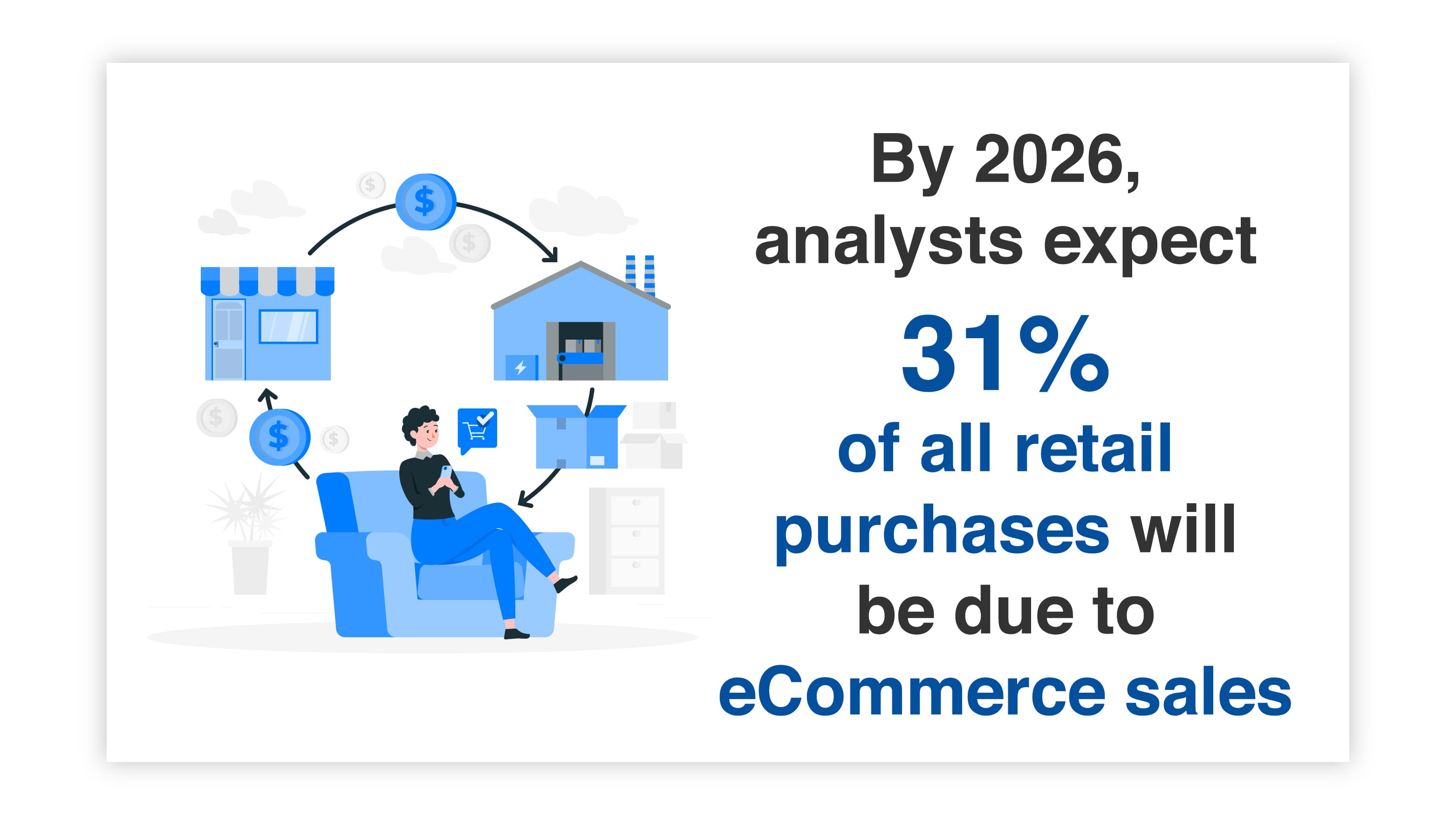
Spurring this growth is technology. A growing number of consumers turn to their smartphone or tablet when they want to research and purchase products. Retailers are harnessing the power of mobile shopping by pushing advertising and marketing specifically for the mobile shopper.
Retailers are also using social media to reach consumers, and those consumers are responding. A recent survey found that 46% of consumers plan to use shopping features within a social media platform.
This growth has been great for online retailers but has also represented a challenge. Keeping up with growth and demand are two necessities for eCommerce businesses that wish to remain competitive. In today's retail environment, that often means thinking outside the box and even outsourcing logistics operations.
As a business grows, so does the need for more efficient logistics operations. Enter the rise of the fulfillment and distribution center. What’s the difference between the two? And does it matter?
To help you figure out what is best for your eCommerce business, we will break down the differences between fulfillment centers and distribution centers, with a complete list of pros and cons.
This way, when the time comes to grow and scale your eCommerce business, you will have all the information you need to make a smarter decision.
We start with the fulfillment center. In short, a fulfillment center is a third-party logistics service or 3PL. A 3PL uses a warehouse with a dedicated staff to help eCommerce businesses store and ship their products to customers.
A fulfillment center might offer basic logistics services or handle every aspect of storage, picking, packing, and shipping. They might also offer return logistics services, inventory management tools, and other add-on services that can greatly benefit eCommerce businesses.
Many eCommerce businesses start small, making it possible for business owners to handle logistics activities in-house. But as businesses grow and orders start flowing in, it can be helpful, and sometimes necessary, for businesses to consider outsourcing these activities.
This frees up time and resources for other growth-related activities. It also helps to guarantee that customer satisfaction won’t suffer because of logistical snags and backlogs.
There are numerous factors that eCommerce businesses should consider when choosing a fulfillment center.
From location to services offered and, of course, cost – these factors will often make or break the success of a logistical partnership.
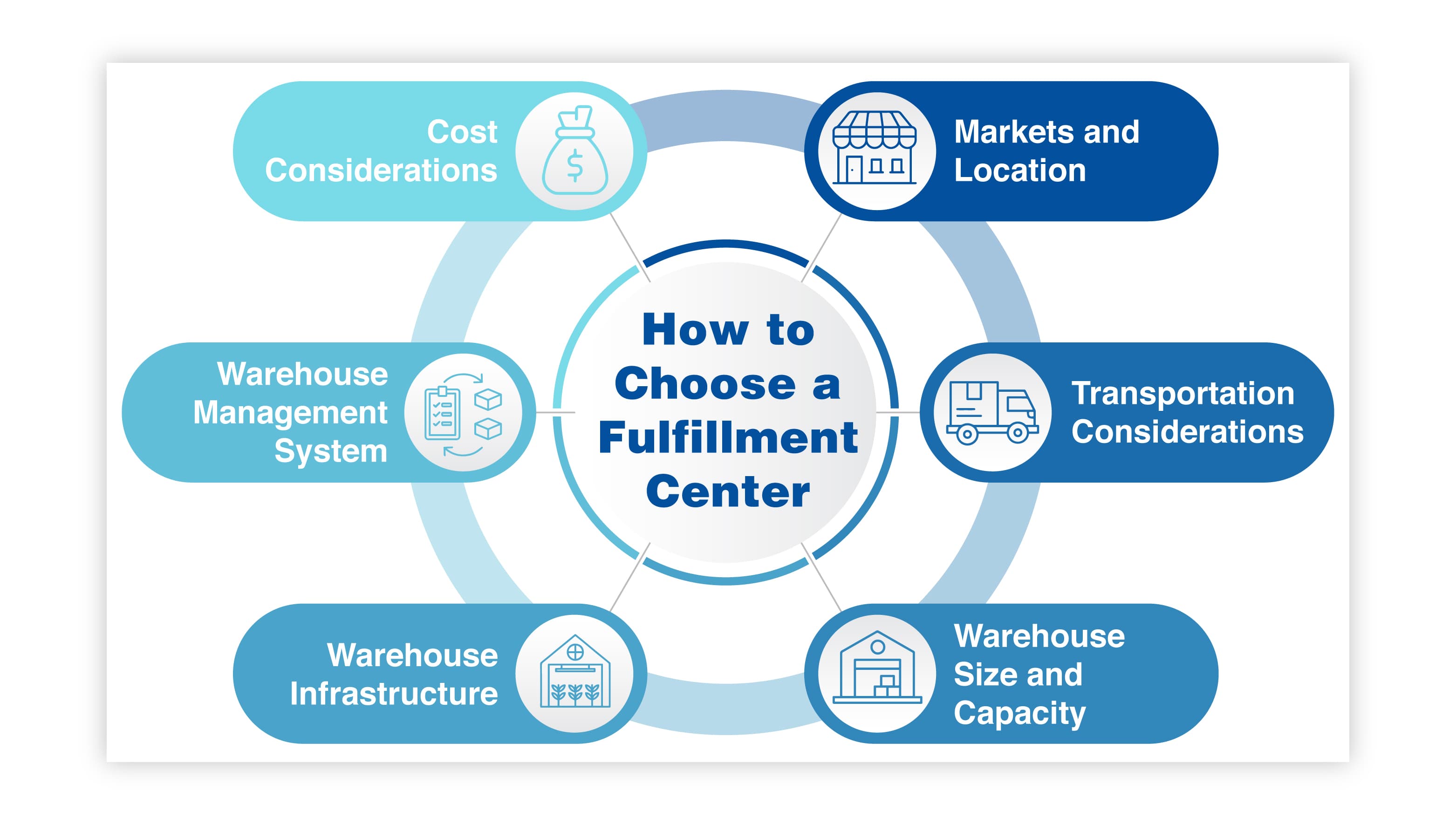
Markets and Location
A fulfillment center will be most effective if it is close to your target market and suppliers. The faster you can get the product to the fulfillment center and from the fulfillment center to your customers, the happier those customers will be.
Look at the entire supply chain to understand where weaknesses might occur and look for a centrally located fulfillment center for the best results.
Many 3PLs offer a network of locations so businesses can spread their inventory across the country, or even the globe, for faster shipping to customers.
Transportation Considerations
The cost of transporting your goods will add to your bottom line. And business owners can sometimes get sticker shock, especially with the cost of transportation skyrocketing. Consider even the smallest details regarding the fulfillment center’s location.
Is it close to highway access? Is it in a rural area or centrally located in a transportation hub? Is the local traffic heavy enough to cause delays? Consider the total cost of transportation from a cash expenditure and customer satisfaction perspective.
Warehouse Size and Capacity
An obvious consideration for choosing a fulfillment center should be size and storage capacity. But it’s important to look at the business's requirements today and peer into the future.
Choose a fulfillment center that can grow with you. Look one, five, and ten years down the road. Consider how much growth you expect and whether your chosen fulfillment center can grow with you.
Warehouse Infrastructure
A fulfillment center should meet the specific requirements of the business. That means providing the right environment for the safe storage and transport of goods, and those requirements might vary depending on the type of product you sell.
For example, businesses selling perishable or temperature-sensitive products should ensure the 3PL they choose has temperature-controlled environments and careful monitoring.
Also, look for a fulfillment center that makes the most of the technology available, including things like automation, AI, and robotics.
Warehouse Management System
Today's fulfillment centers often have complex management systems that integrate with the business itself.
Look into the details of what the 3PL offers regarding integration and technology. Other considerations include the skill level of the workforce because, in a fulfillment center, you will be relying on them.
Cost Considerations
When considering a fulfillment center vs. a distribution center, understand that choosing the former typically comes with a higher cost. However, those extra dollars go toward additional services businesses would otherwise have to cover themselves.
If spending a little more here will help you cut costs elsewhere and improve customer satisfaction simultaneously somewhere , then it might be money well spent.
Choosing between a fulfillment center vs. a distribution center requires looking at the pros and cons of each. A fulfillment center offers many benefits for eCommerce businesses, including:
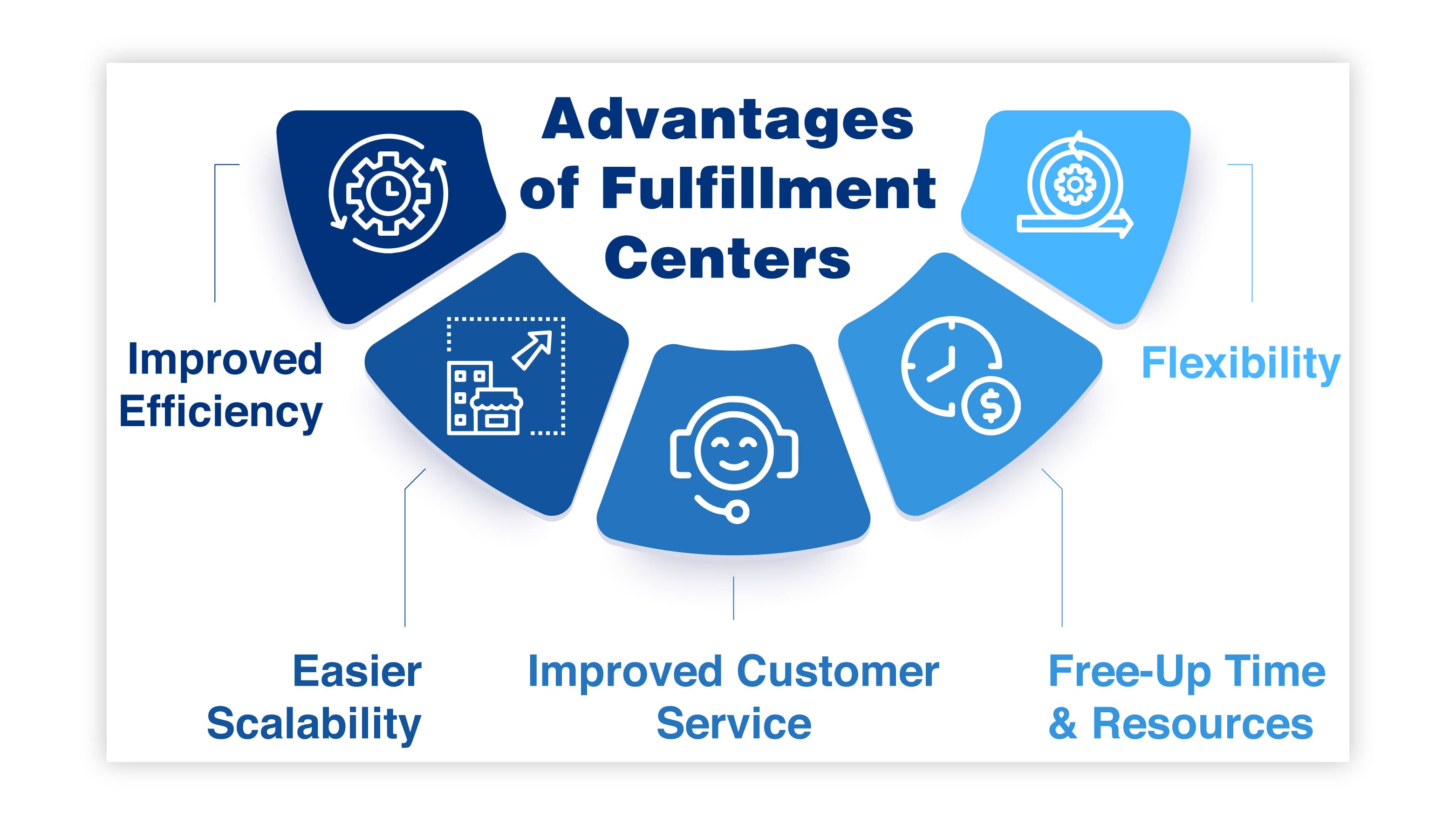
Picking, packing, and shipping are big tasks for businesses, and they get bigger as the business grows. Employing a team of experienced and skilled workers to take over these jobs for you provides a more efficient and successful outcome. 3PLs have the tools, infrastructure, and labor force ready to help businesses be more efficient in their day-to-day operations.
Growing a business is hard enough already. To do it right, business owners must have the right infrastructure in place beforehand, especially regarding logistics.
There’s no point in doubling your customer base if you can’t fulfill those extra orders. Utilizing a fulfillment center means the tools you need are already in place and ready to go when the time is right.
Ecommerce, and retail in general, centers around the customer. If your customers are not happy, chances are the business will struggle. Using a fulfillment center betters your chances of nailing logistics operations, including ensuring customers make their purchases on time.
All the tasks involved with logistics take up a significant amount of time, energy, and money. If you’re a solo entrepreneur or starting with a small team, these tasks can quickly become overwhelming.
Suddenly, you’re forced to spend all day packing and shipping orders, with no time left for marketing, customer service, or other business management tasks. Handing these jobs off to someone else means spending more time and energy on growth-focused activities.
A fulfillment center is a great option for eCommerce businesses because of the level of flexibility involved. Businesses can choose between third-party logistics providers or in-house fulfillment centers. And you can choose from a menu of services, meaning you can customize your fulfillment center to meet your needs.
Ok, now that we understand the first side of fulfillment centers vs. distribution centers, you might wonder what makes a distribution center different. Well, in a lot of ways, the services these two entities provide overlap. Therein lies the confusion.
But to make it easier to understand, think of it like this: a fulfillment center focuses on fulfilling orders while a distribution center mainly focuses on distributing goods to the right place.
A distribution center is an intermediary between the supplier and the business. Businesses have products shipped from the supplier to the distribution center to be held until it is time to move them elsewhere. That might be to the business itself, a physical brick-and-mortar location, or, yes, even directly to the customer.
Distribution centers often have a better capability to store large quantities of inventory long-term, and a better infrastructure set-up to quickly move large pallets of goods.
Think of it like a warehouse “plus.” Instead of a business renting, maintaining, and staffing its own warehouse space, a distribution center does it for you.
Does a distribution center also pick and pack orders to be shipped directly to customers? The answer is yes, sometimes. A distribution center may handle some or all of the fulfillment tasks for you as well.
A distribution center can also handle the reverse logistics end of the business. That means they will process returns from the customer, inspect the returned goods, determine their condition, and refund the customer. They may also send damaged products back to the manufacturer.
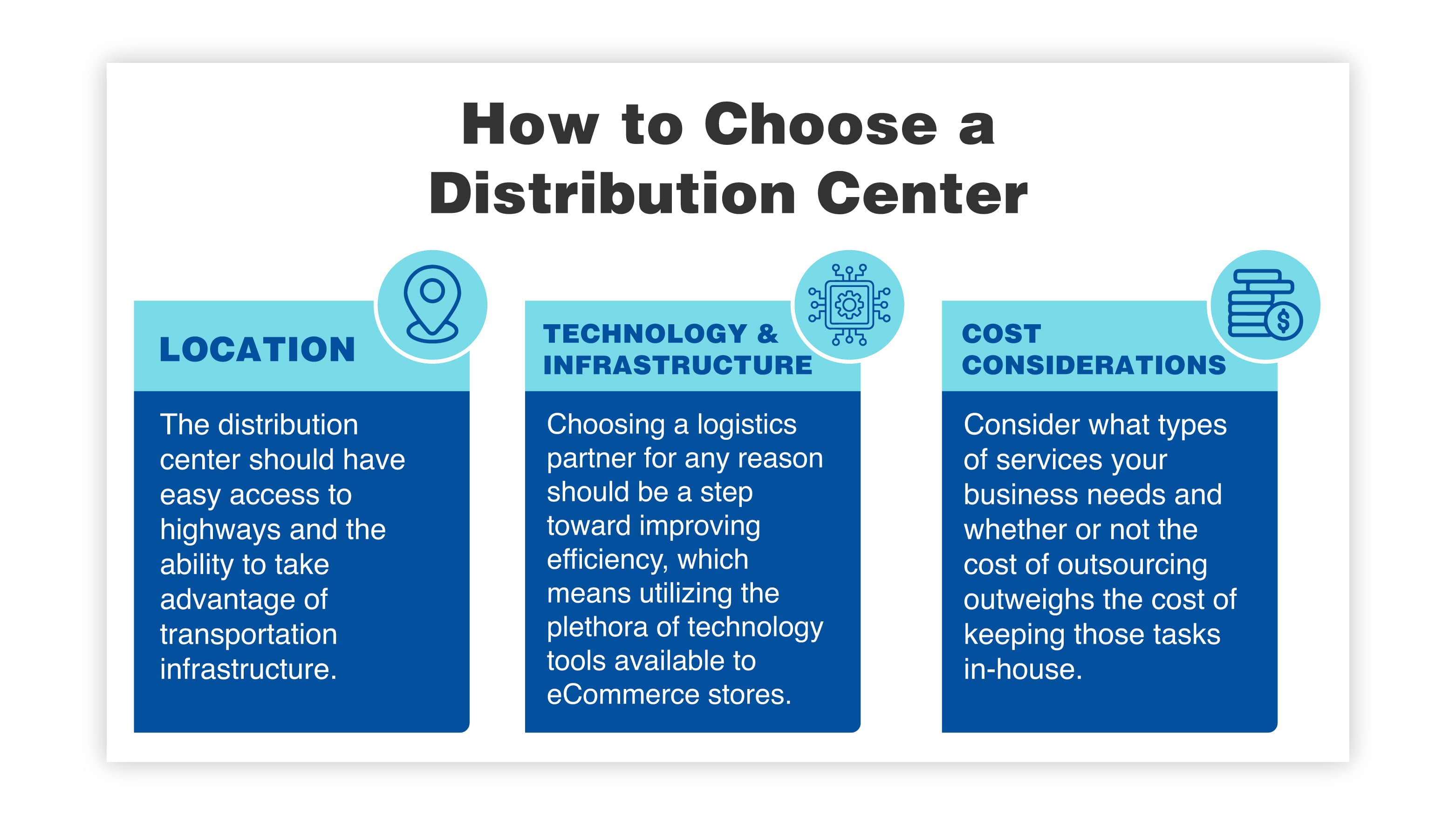
Location
Like a fulfillment center, the location of a distribution center matters. Because a distribution acts as a stop on the logistical highway, it should be centrally located, close to suppliers and customers.
It should have easy access to highways and the ability to take advantage of transportation infrastructure.
Technology and Infrastructure
You simply cannot mention logistics today without including technology. Choosing a logistics partner for any reason should be a step toward improving efficiency, and there’s no better way to do that in today’s eCommerce landscape than by utilizing the plethora of technology tools available.
Cost Considerations
A distribution center usually costs less for businesses than a fulfillment center. However, outsourcing any task will involve a cost. Consider what types of services your business needs and whether outsourcing costs outweigh the cost of keeping those tasks in-house.
When considering the benefits of a fulfillment center vs. a distribution center, you will probably notice that there is a bit of an overlap.
Both will provide an eCommerce business with a better ability to satisfy customers and improved efficiency in logistics operations. But a distribution center does offer some unique benefits as well.
There is no denying that outsourcing logistics services can help a business be more efficient. With the right tools and infrastructure in place and a dedicated team of experienced workers handling the heavy lifting, businesses will certainly see improvement in their ability to quickly and accurately receive, store, and ship their products.
All you need to do to calculate the savings businesses gain from using a distribution center is consider the cost of the tasks they will handle.
For example, a business of any considerable size will probably need a warehouse, the infrastructure to run that warehouse, labor costs, transportation costs, and more.
Choosing a distribution center represents an upfront cost but also eliminates many of the costs associated with those tasks.
A distribution center can help eCommerce businesses expedite their order fulfillment process.
Choosing one that is located close to a target market can help ensure that customers get their orders shipped as quickly as possible and at the lowest cost – two things that are beneficial for both the customer and the business itself.
According to Statista, 41% of online shoppers expect delivery of their purchases within 24 hours. And with an increased focus on last-mile delivery, 25% prefer their delivery to occur within just two hours. Customers expect fast, accurate delivery and a distribution center can help eCommerce businesses ensure this happens.
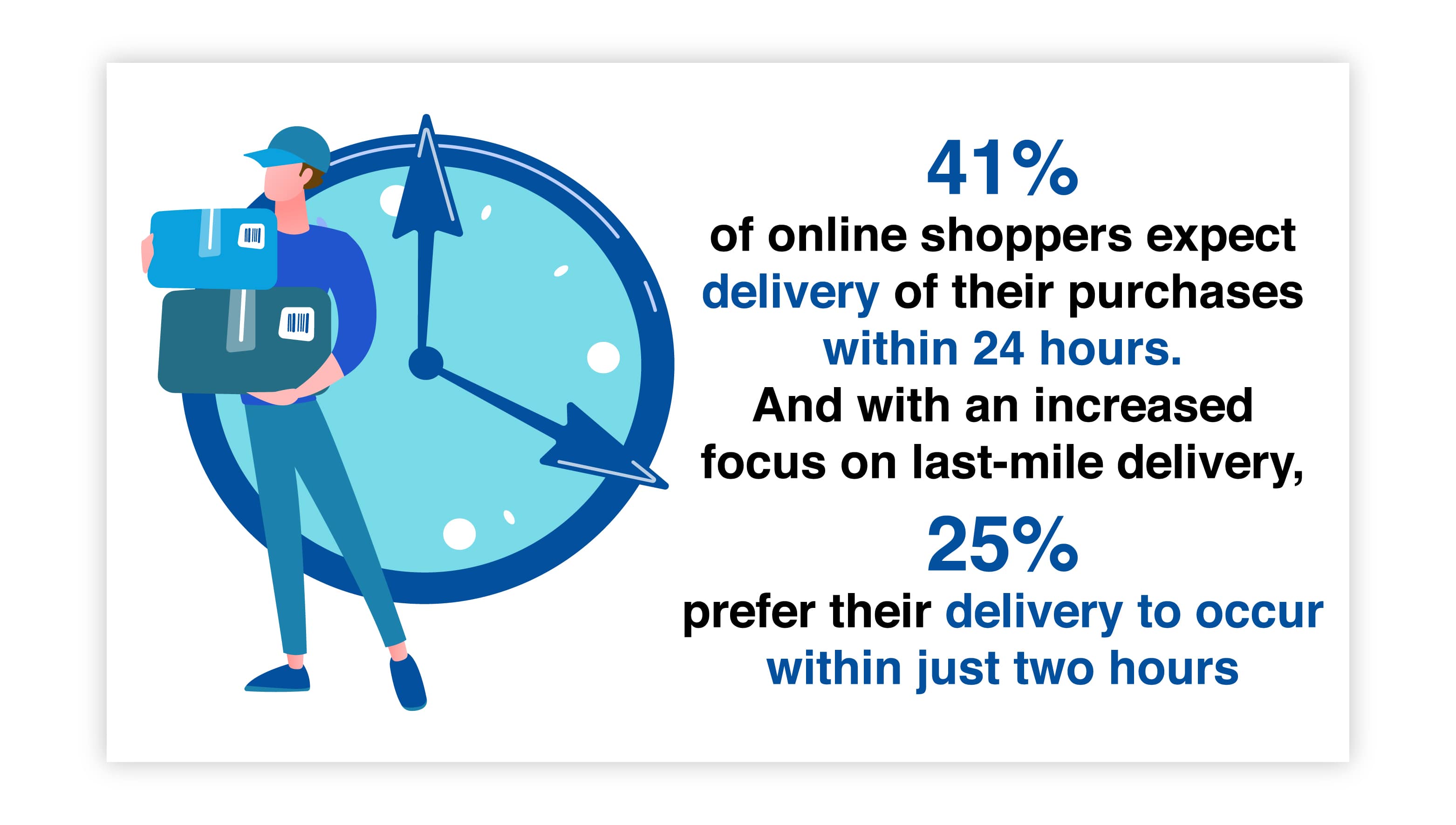
Distribution centers can often ship products in bulk at a much lower cost. This means that businesses can save on transportation costs, something that can add a great deal of cost to a business's bottom line.
In essence, there are more commonalities between fulfillment centers vs. distribution centers than differences. But understanding the subtleties of this topic is key to choosing the right logistics partner for your eCommerce business.
Fulfillment Centers – Fulfillment centers can be considered a “do-it-all" logistics partner. They are more specialized in having the right infrastructure for picking, packing, and shipping customer orders.
For an eCommerce company, these tasks are essential for success. It only takes one mistake to lose a loyal customer forever, and not many to turn a successful business into a failing one.
A fulfillment center helps eCommerce businesses nail their logistics operations from start to finish. This takes a lot of the responsibility and burden off the business itself. However, outsourcing is always a double-edged sword.
An unhappy customer won’t see any difference between your business and the 3PL partner you choose. That’s why making an educated and researched decision is so important.
Distribution Centers – A distribution center might handle the order fulfillment process, but its real specialty lies in the warehousing portion.
A distribution center is typically used for storing inventory until it is needed. The inventory is carefully sorted and stored until it's time to ship to customers or retail outlets.
So, both a fulfillment and distribution centers are used to help eCommerce businesses streamline their logistics operations. The main difference is that a fulfillment center focuses mainly on the order fulfillment portion of the equation.
A distribution center is essentially a warehouse that focuses mainly on storing and moving inventory to where it needs to go. And sometimes, goods are moved from a supplier to a distribution center on their way to a fulfillment center before heading off to the customer.
Now that we’ve dug into the differences between a fulfillment center and a distribution center, we can talk more about how eCommerce businesses determine the best choice for their needs.
And in that very sentence lies the answer. Every business is different, and a specific business's needs will help determine the right choice.
Fulfillment and distribution centers are essential parts of the supply chain, but they have very different roles.
A fulfillment center is designed to improve the efficiency of the order fulfillment process, including all the steps involved with that task – picking, packing, and shipping orders directly to customers.
A distribution center, however, is more suited for handling and storing large quantities of inventory in preparation for movement. They have a better capability to safely store and manage inventory, especially when it’s in bulk.
And they have a more cost-efficient way to ship bulk orders directly to retailers, outlets, and wholesalers.
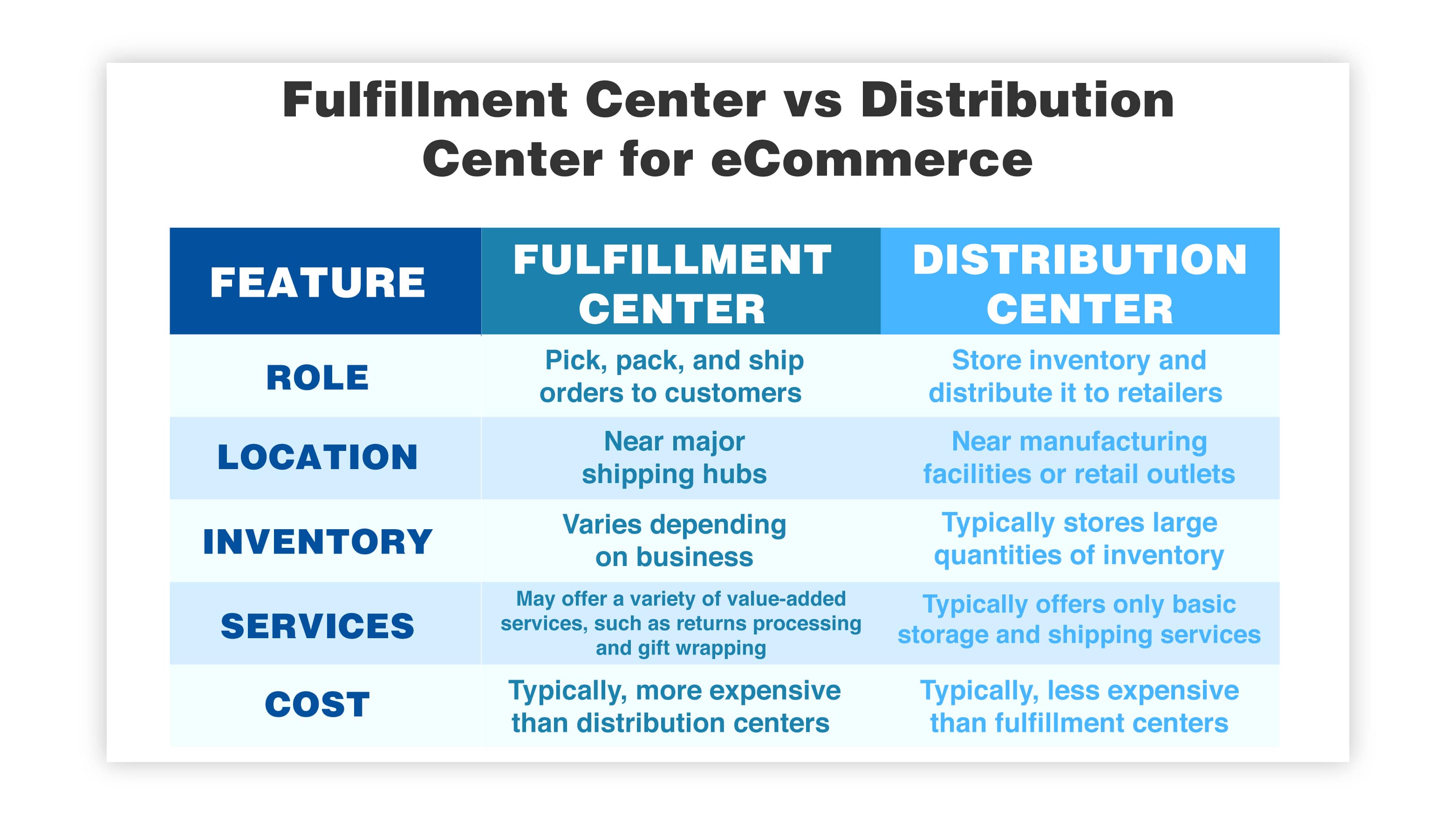
Again, the safest way to make any business decision is to evaluate the specific needs of the business and balance them against the options available.
Businesses that do a very high volume or need a very high-touch fulfillment solution will benefit the most from a fulfillment center. However, businesses that need a lower volume order fulfillment solution but require a larger storage capacity at a lower cost might benefit more from using a distribution center. And still, others may need both at once.
Understanding the needs of the business, and the differences between fulfillment centers and distribution centers, can help owners make the right choices regarding their logistics operations. But let’s not overlook one of the biggest considerations required for any business decision – cost.
Keeping costs low is essential for businesses for two reasons. First, it keeps operating expenses low which means more of the budget left over for other activities and more revenue left as profit when all is said and done.
Secondly, it keeps costs low for the customers. Higher costs for the business usually turn into higher costs for the customer, and that’s a scenario that leaves everybody unhappy.
To understand the cost of using a fulfillment or distribution center, you must understand exactly what contributes to that cost.
Fulfillment Center Costs – The costs associated with a fulfillment center are essentially the total costs of storing, picking, packing, and shipping orders. You can break these costs down into three main categories:
Distribution Center Costs
A distribution center operates differently than a fulfillment center. That means the costs for the business are different as well. When selecting a distribution center, there are four main costs to consider:
These costs are passed on to the business. The best way for businesses to reduce fulfillment costs is to optimize their fulfillment process and choose the right partner.
Consider not only the cost to the business, but also how much time, money, and energy you can save by outsourcing your logistics operations. And consider how much a boost in customer satisfaction will help the business grow.
We can’t speak about logistics without mentioning the elephant in the room: returns and reverse logistics.
While every business loves to sell, few enjoy the process of reverse logistics. It’s an unfortunate cost of retail and one that must be handled carefully if you want to keep customers happy – and keep them coming back.
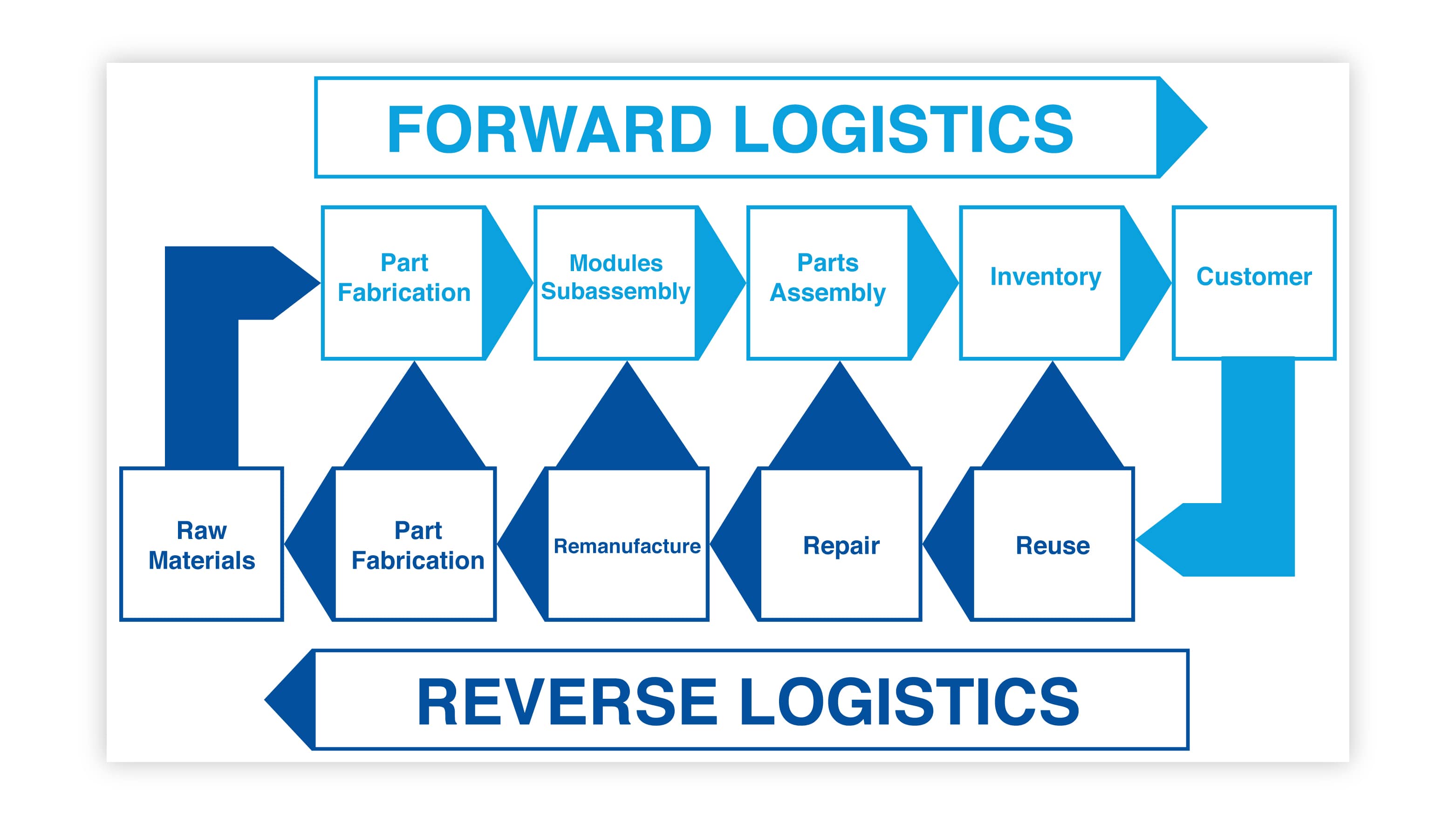
Reverse logistics is the process of moving goods from the end consumer back through the supply chain. Returned goods either end up back with the retailer or back to the manufacturer.
Reverse logistics can include returns, recalls, repairs, remanufacturing, and recycling. Having a logistics partner who can help manage this process will be beneficial.
Depending on the size and scale of an eCommerce business, handling returns can be a straightforward process, or it can be incredibly complex and time-consuming. Chances are that the complexity of your returns process will grow along with the business itself.
When it comes to reverse logistics, the choice of fulfillment centers vs. distribution centers comes up again. Choosing the right one for your business should consider the type of products you sell, and therefore, the type of products you are likely to see come back as returns.
Businesses that deal in bulk orders, once again, will likely benefit from a distribution center that can handle reverse logistics on a large scale. Businesses focused on the end consumer, on the other hand, may benefit from the specialty reverse logistics services offered by a fulfillment center.
There are many factors to consider when choosing between a fulfillment center and a distribution center for your eCommerce business. As always, take a long, hard look at the specific needs, including things like product type, order volume, and budget.
Decide where the greatest need for your business is in terms of logistics and order fulfillment and make the choice that fills those needs the most effectively.
Remember that fulfillment centers are a great option for businesses that need a high-volume, high-touch solution. A fulfillment center can help businesses improve their efficiency, make scalability easier and more achievable, and boost customer service results.
Distribution centers can be a better option for businesses that need a lower-volume, and lower-cost, fulfillment solution.
Distribution centers are a great tool for improving efficiency and reducing warehousing costs. However, businesses will find less flexibility in a distribution center. This means it might be harder to meet the needs of the end customer.
It’s for these reasons that choosing the right solution is so essential. Weigh the pros and cons and choose the option that makes the most sense for your business. And remember to think a few years ahead.
Choose a logistics partner that can grow with you, uses innovation and technology to your advantage, and fits within your budget.

The supply chain is a term used to describe all the components required to transport goods from beginning to end, from production to the end...
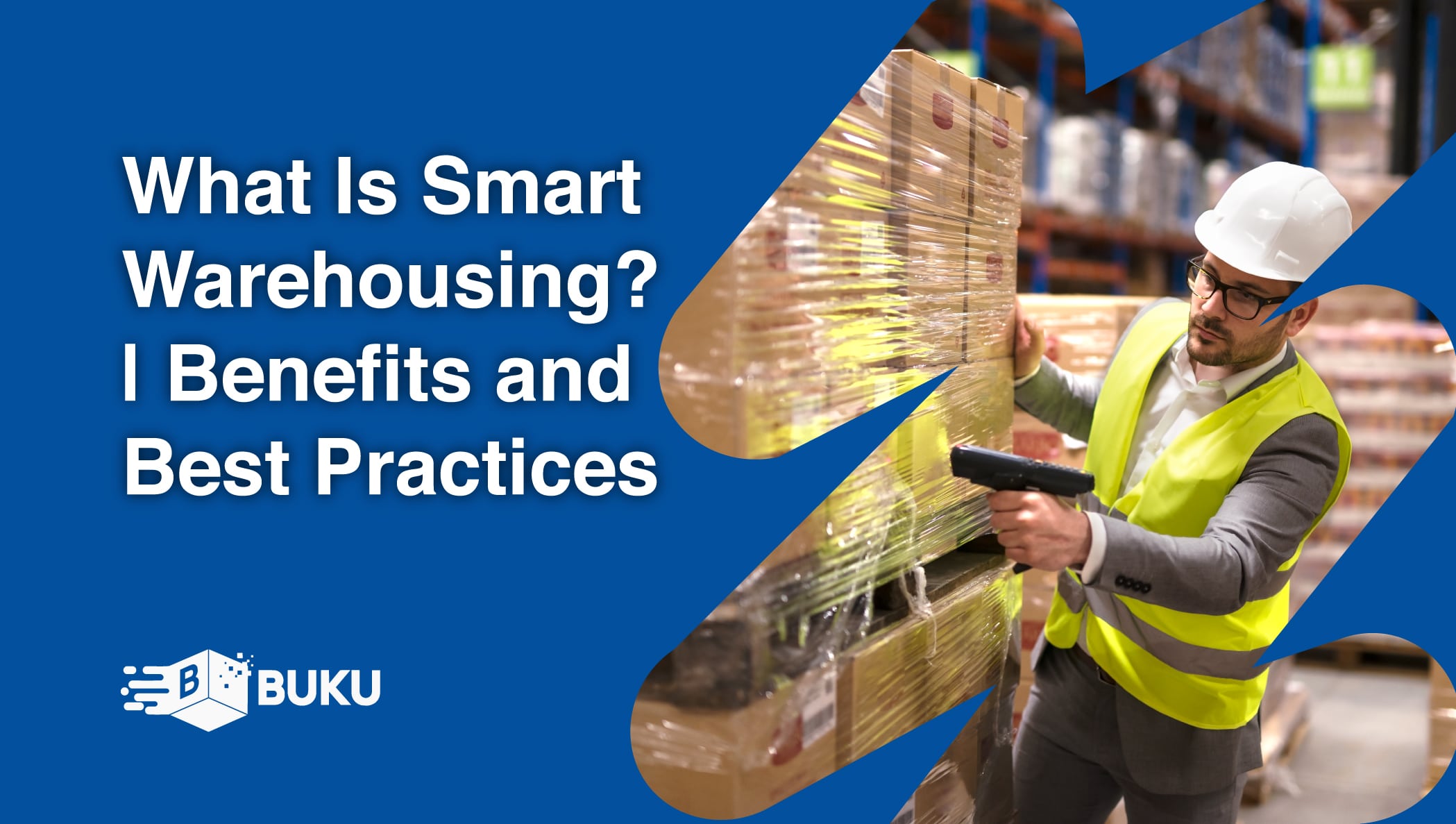
A smart warehouse is a large building where raw materials and other consumer goods are stored using machines, computers, comprehensive software, and...
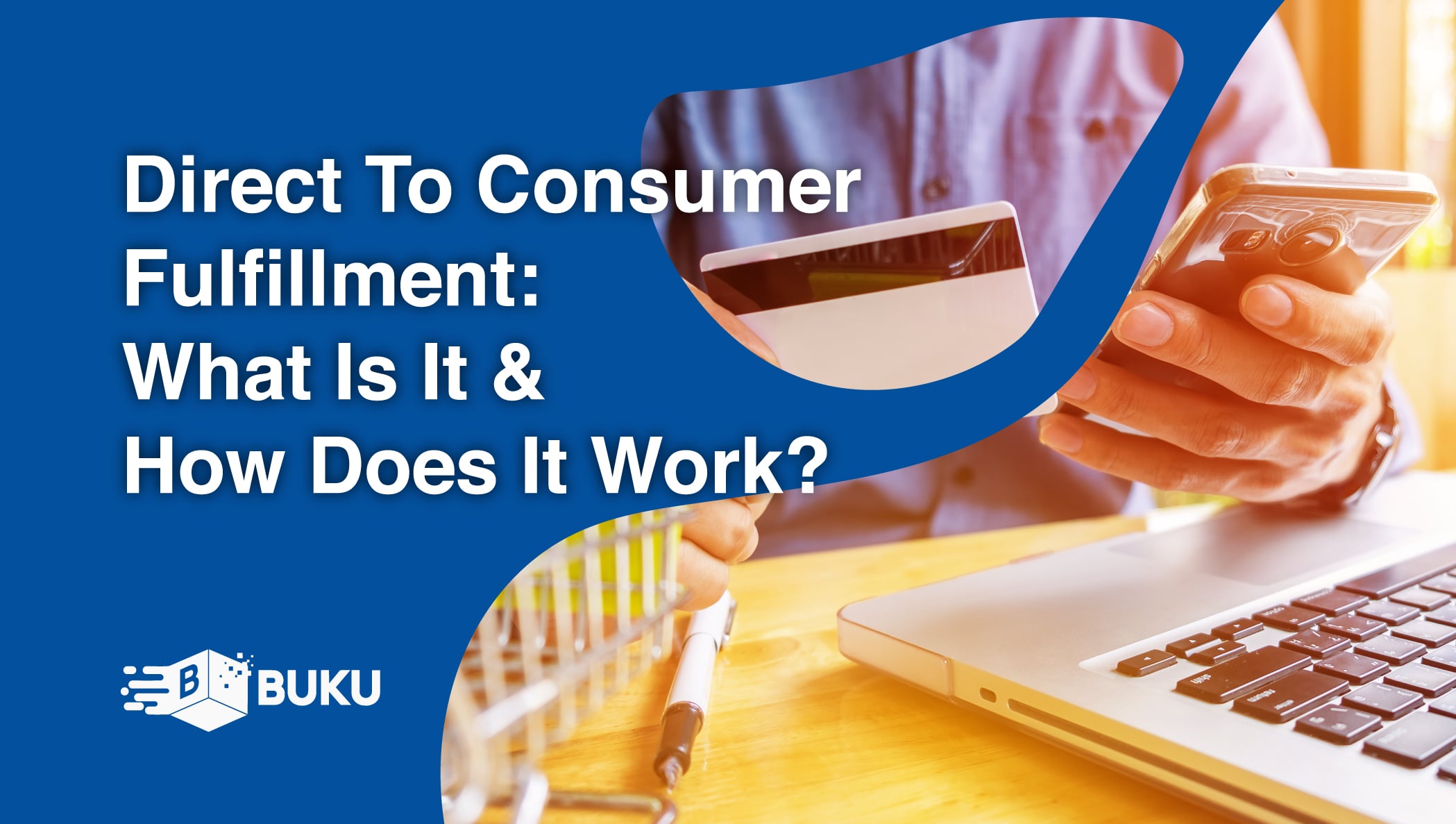
Direct-to-consumer (DTC) fulfillment is a strategy that helps brands sell and deliver their products directly to customers more efficiently while...